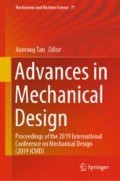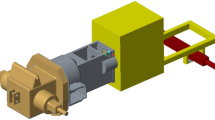Abstract
With the continuous increase of China’s high-speed railway and the improvement of passenger vehicle dynamics and static performance requirements, the gearbox housing of the core component of power transmission is facing a severe test. Based on theoretical mechanics and finite element method, this paper calculates the static strength and modal state of high-speed EMU gearbox housing based on ANSYS software, and compares the relevant data. It is concluded that the static strength and modal strength of the gearbox housing meet the actual requirements.
The authors would like to thank anonymous reviewers for their helpful comments and suggestions to improve the manuscript. This research was supported by the National Natural Science Foundation of China (Grant No. 51665015), the Natural Science Foundation of Jiangxi Province (Grant No. 20181BAB206025), and the Science and technology project of Jiangxi Education Department (Grant No. GJJ180328).
Similar content being viewed by others
Keywords
1 Introduction
As an indispensable universal component for connecting and transmitting power in mechanical transmission systems, the design level and manufacturing technology of the gearbox housing reflect the country’s comprehensive national strength and market competitiveness to some extent. Moreover, with the rapid development of science and technology, higher requirements are put forward on the force analysis, static strength analysis and modal analysis of the gearbox housing [1,2,3].
The gearbox housing is a key component of the EMU, and whether the train can run or not is closely related. As the speed of the vehicle increases, the power of the vehicle continues to increase, and the gearbox housing faces a more severe test [4]. In this paper, ANSYS software is used to analyze the static strength and modal analysis of high-speed EMU gearbox housing.
2 Static Strength Analysis of the Gearbox Housing
Static strength analysis is the core of structural finite element analysis. The structural strength of the aluminum alloy material used in the gearbox housing is worse than that of common cast iron alloys. Therefore, it is necessary to check the strength of the gearbox housing [5].
2.1 Establishment of Finite Element Model
The finite element model established by using Hypermesh software is shown in Fig. 1. The model is imported into the ANSYS Workbench module for processing and analysis.
2.2 Establishment of Finite Element Model
The static strength analysis of the gearbox housing is carried out under the condition of starting forward rotation, and the stress cloud of the gearbox housing is obtained, as shown in Fig. 2.
It can be concluded from the stress cloud diagram of Fig. 2 that the maximum stress is 40.695 Mpa. By referring to the relevant guidance in TB/T 3134-2013: the maximum stress of the aluminum alloy case should be less than one-fifth of the yield strength of the material to meet the requirements when the traction motor is applying the limit starting torque.
The verification result of starting the forward transmission condition is shown in Fig. 3. By drawing the curve by hand and drawing the coordinate points corresponding to the stress values, it is concluded that all the stress points are within the standard area and the working conditions are qualified.
3 Modal Analysis of Gearbox Housing
Modal analysis is the basis for in-depth improvement of the gearbox housing. ANSYS software provides excellent power analysis tools. The three main indicators commonly used in modal analysis of general engineering problems are modal frequency, modal damping and mode shape [6]. These indicator data can further determine the vibration mode, natural frequency and other coefficients of the gearbox housing. This lays a good foundation for the modal analysis of the gearbox housing [7].
3.1 Basics of Modal Analysis
The modality of an object is not only an inherent property of the elastic system, but also a holistic feature. Modal analysis allows us to gain a deeper understanding of the modal response of the gearbox housing at each stage, especially near the natural frequency. Based on the above characteristics, we can predict the actual vibration of the gearbox housing in this frequency range and its response. Modal analysis is a critical step in the dynamic design of the EMU gearbox housing and its fault detection. This chapter performs a third-order modal analysis of the gearbox housing.
3.2 Solution Results and Analysis
It can be concluded from Fig. 4 that the frequency of the gearbox housing in the first-order modal analysis is 637.79 Hz, and the maximum displacement is 12.127 mm. The maximum displacement position in the gearbox housing is also a small displacement in the y direction in the z-direction. This displacement is not the deformation of the gearbox housing under actual working conditions, but only the modal displacement of the part at the current frequency. The meaning expressed is a structural aspect of the component.
It can be seen from Fig. 5 that the frequency of the gearbox housing in the second-order modal analysis is 876.5 Hz, the maximum displacement is 12.529 mm, and the maximum displacement position is the z direction in the bottom of the gearbox housing. This displacement is not the deformation of the gearbox housing under actual working conditions, but only the modal displacement of the part at the current frequency. The meaning expressed is a structural aspect of the component.
It can be seen from Fig. 6 that the frequency of the gearbox housing in the third-order modal analysis is 970.52 Hz, the maximum displacement is 55.398 mm, and the maximum displacement position is the z-direction inside the gearbox housing. This displacement is not the deformation of the gearbox housing under actual working conditions, but only the modal displacement of the part at the current frequency. The meaning expressed is a structural aspect of the component.
Based on the above data, the amplitude of the gearbox housing in the third order is 55 mm frequency 970.52 Hz, which is close to the resonance frequency. Therefore, the operating frequency should be avoided as close as possible to 970.52 Hz to prevent resonance from damaging the cabinet in the design process.
4 Conclusion
The three conclusions obtained from this paper are as follows:
-
(1)
The maximum stress of the gearbox housing in the ANSYS Workbench module is 40.695 Mpa, which meets the static strength requirement standard under the condition of starting forward rotation.
-
(2)
The results are verified under the condition of starting forward rotation, and all the stress points are in the standard area, so the working condition is qualified.
-
(3)
The amplitude of the gearbox housing in the third stage is 55 mm frequency 970.52 Hz, which is close to the resonance frequency. In the design process, the gearbox housing working frequency is avoided as close as possible to this frequency.
References
Huang, Q.: Modal analysis and experimental research of gearbox housing based on ANSYS. J. Water Resour. Hydropower (2016)
Yun, J.: The strength analysis and optimization design of the EMU gear transmission. Lanzhou Jiaotong University (2015)
Chen, X.: Research on noise reduction and feature extraction method of gearbox housing vibration signal. Taiyuan University of Technology (2018)
Yang, J., Yang, M.: Strength analysis and experiment of high speed railway gearbox housing bracket. Open Mech. Eng. J. 9(1), 266–270 (2015)
Zhang, F., Qi, P., Wu, X., et al.: Analysis of the influence of wheel polygons on axlebox of high-speed train. Vibr. Testing 38(05), 187–192+212 (2018)
Wang, X., Li, Z., Feng, Y., et al. Modal experimental study and simulation analysis of reciprocating compressor housing. J. Ordnance Equip. Eng. (6), 87–90 (2014)
Xian, X.: Design and dynamic characteristics analysis of non-circular gear transmission experimental device. Lanzhou University of Technology (2015)
Author information
Authors and Affiliations
Corresponding author
Editor information
Editors and Affiliations
Rights and permissions
Copyright information
© 2020 Springer Nature Singapore Pte Ltd.
About this paper
Cite this paper
Huang, H., Yin, B., Wang, C., Zhu, H. (2020). Strength and Modal Analysis of High Speed EMU Gearbox Housing. In: Tan, J. (eds) Advances in Mechanical Design. ICMD 2019. Mechanisms and Machine Science, vol 77. Springer, Singapore. https://doi.org/10.1007/978-981-32-9941-2_19
Download citation
DOI: https://doi.org/10.1007/978-981-32-9941-2_19
Published:
Publisher Name: Springer, Singapore
Print ISBN: 978-981-32-9940-5
Online ISBN: 978-981-32-9941-2
eBook Packages: EngineeringEngineering (R0)









